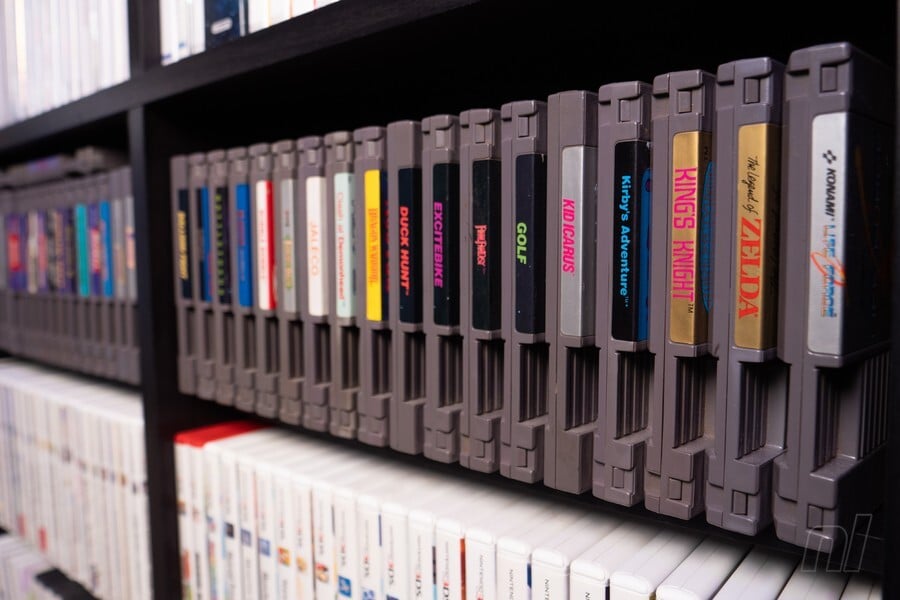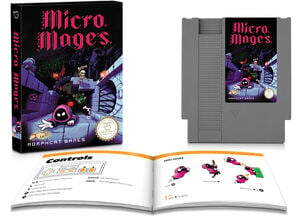
Four decades after it became an international sales phenomenon and dominated a crowded games market, the Nintendo Entertainment System – the 8-bit box that gave birth to some of the medium’s biggest enduring franchises – today finds itself playing host to something else entirely: new aftermarket IPs that are strikingly polished and joyously fun.
The homebrew scene for the NES has flourished over the two decades, especially so with the rise of tools like NESmaker in 2018, which makes developing for the console far more approachable. Inspired by pioneer developers, the minds behind Morphcat Games earned their stripes coding games from scratch using 6502 assembly language.
Enter Micro Mages. An homage to NES-era platformers, the 2019 game was the subject of a viral YouTube making-of video that showcased clever optimization techniques employed by developers Julius Riecke and Nicolas Bétoux, who tasked themselves with limiting their game to just 40 kilobytes, in keeping with the file size of the iconic NES launch title Super Mario Bros.

Scroll through the YouTube comments, and the general sentiment is: “Had this come out during the NES’ heyday, it would have been a gaming milestone.” Physical copies of Micro Mages run seamlessly on original NES hardware, though its physics and gameplay, which supports up to four players, feel decidedly modern to the touch, with gorgeous pixel art to boot.
we noticed that new gamers also enjoy this old-school physical experience
“Creating a ‘Nintendo game’ was a dream of mine since I was young,” says Riecke, speaking to Nintendo Life. “Back in the day, even though I never had an NES of my own, I always looked forward to playing one at a friend's house. I suppose that this circumstance and the great times we had together are what put it on a pedestal for me.”
Riecke and Bétoux, who are based in Berlin, cited titles like Kirby’s Adventure, the Super Mario Bros. series, and Mega Man 2 as having left a lasting impression. “Later, we discovered Mr. Gimmick and Little Samson which impressed us too! All these games have a high level of polish, taking care of each detail. Really impressive and inspiring.”
Riecke began tooling with NES development in 2005 and linked up with Bétoux in 2015. The duo at Morphcat Games now have a handful of lauded aftermarket NES games under their belt. With Riecke handling programming and sound and Bétoux creating graphics and levels, the pair have made a niche name for themselves by pushing the vintage hardware to its limits.
“Back in 2005, things looked different: I grabbed all the tech docs I could find and spent a couple of weeks reading them over and over again until the puzzle pieces started falling into place,” says Riecke. “Nowadays, the state of the NES's documentation is excellent. While we use assembly like veteran developers did, the tools available nowadays are MUCH improved.”
While coding in assembly language, known to be much closer to the binary machine code that a computer's CPU understands, is undoubtedly very demanding and time-consuming, "the benefit is that you have control over every aspect of the NES," Riecke says. "It also helps in understanding exactly how much CPU time each part of your code uses.”

While modern tools have greatly streamlined the NES development process, "hand-written assembly still outperforms code written in a higher-level language like C on the NES," Riecke adds. "This allows for really pushing the console's limits beyond anything seen back in the day. I dare say that, still, no one has come close to exhausting its full capabilities."
Bétoux likewise finds joy in pushing the limits of the hardware’s graphical constraints. “I started learning 6502ASM with Nerdy Nights in 2011, a series of great tutorials for beginners” hosted by the now-defunct NintendoAge forum. “The NES graphics limitation is so appealing and it's also challenging for creativity. There's so much to explore!”
Apart from 2019’s Micro Mages, the Morphcat duo has since published Böbl in 2020, a water physics-based Metroidvania with a striking soundtrack and emphasis on exploration, and Spacegulls in 2021, which colorfully fuses the controls of Joust with elements from the Mega Man series. Both titles were made for NESdev Compo and were capped at a more lenient 64KB limit.
“The level of ROM space optimization we did on Micro Mages took a long time indeed. But doesn't everything become manageable if focused on one step at a time? That's what we did, we got lost in an optimisation maze for a while, not knowing where it would lead us, but it's been so much fun that we didn't mind,” Riecke says.
Fewer memory constraints meant that the pair needed less time to optimise, although Böbl, in particular, which casts the player as a literal bubble, “was all about optimising code to run smoothly on the NES' 1.7MHz CPU. The water surface ripple effect alone takes over 50% of the available CPU time.”
The duo spent nights and weekends powered by sushi and pizza to complete Böbl entirely within a single month. “With Spacegulls, we just had fun and could focus on exploring game design with the tools we had already built for Böbl. However, the deadline was even shorter: one week from start to finish.”
For all the crunch time involved, Morphcat’s output gives no hint of it. For the curious, a slick physical edition of Böbl, Spacegulls and Micro Mages: Second Quest – an expanded version of the base game with new elements and increased challenge – is now up for pre-order on a single NES cartridge as part of the Triple Jump collection.

“Physical cartridges with box and manual are so charming. To hold a game and dive into an instruction booklet is so satisfying. In fact, it extended the game experience beyond play sessions,” Bétoux tells us, shedding light on Morphcat’s partnership with publisher Broke Studio to release cartridges of Micro Mages and the Triple Jump collection.
Physical releases would have “been impossible” without input from Antoine Gohin, the creator of the aftermarket NES game Twin Dragons and head of Broke Studio, says Bétoux, who shared that the publisher had handled the heavy manufacturing for Micro Mages’ printed circuit board and shell, while the box, manual, and labels were made in-house.
“Bringing [out] a new game is tough and expensive to produce, but it's such a pleasure to see people enjoying the final result. There's also a part of nostalgia for the people who grew up during the 8-bit era, but we noticed that new gamers also enjoy this old-school physical experience, looking to buy a NES console and having fun discovering old and new games.”
Bétoux hints that Morphcat is thinking “a lot" about modern consoles, with something in the pipeline for 2024. “The Nintendo Switch is a great console for local multiplayer games, and much easier than finding an NES Four Score,” referring to the accessory released for the NES in 1990 to enable four-player local co-op - a requirement if you want to play Micro Mages with your friends on the vintage hardware.
“All this fun keeps the NES alive.”